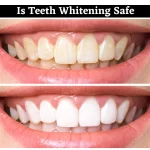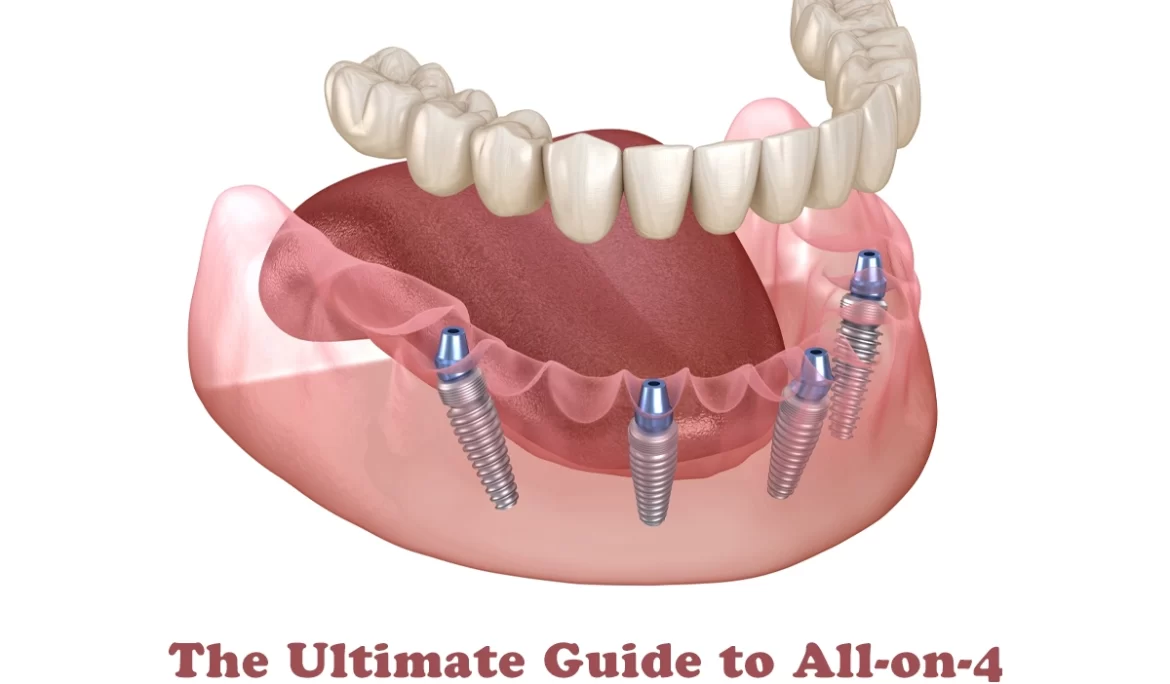[vc_row][vc_column][vc_column_text]Often patients have numerous questions about all-on-4 dental implants and what they do. We’ll answer all these questions in this article and more.
All-on-4 is a revolutionary method for replacing multiple missing teeth and rebuilding a patient’s mouth to restore its full function. It is a technique where four implants replace an entire arch of teeth on the lower or upper jaw.
Losing a complete set or most teeth is unfortunate and can occur due to many factors. An accident, advanced tooth decay, or other oral health problems can result in severe tooth loss. Regardless of the causes, tooth loss is a problem that needs to be dealt with appropriately. One of the most exciting and contemporary techniques for solving the issue of multiple tooth loss is a procedure known as an all-on-4 dental implant.
This guide will help you understand everything you need about all-on-4 dental implants and what to expect during and after treatment.
The History Of The All-On-4 Dental Implants
The concept of having a complete set of teeth supported by implant fixtures is not new. But adopting a posterior implant at a 45° angle led to the evolution of all-on-4.
Prof. Paulo Malo, from Portugal, and implant manufacturer Nobel Biocare were among the first to identify the possible treatment benefits and cost-efficientness of the all-on-4 technique.
In the 1990s, Nobel Biocare financially supported Prof Paulo Malo to perform a series of studies that can determine the efficacy of this unique and ingenious approach. Prof Paulo Malo then treated the first ever patient in 1998 using the all-on-4 dental implant technique.
Today, the all-on-4 implant procedure is widely recognized as the ideal treatment option for a full-arch teeth replacement.
What are All-on-4 Dental Implants?
All-on-4 dental implants, also known as full arch implants, consist of four titanium implant posts. These posts are surgically placed in the jawbone at calculated intervals along the arch and connected to a denture plate.
The all-on-4 implant design replaces an entire arch of teeth to restore your mouth’s functionality and your smile’s appearance. They eliminate the requirement for bone grafting to support the implant because dentists usually pick the thickest part of your jaw to place the posts.
This implant technique is an excellent solution for several missing teeth and involves minor surgery that takes roughly two hours per arch. The entire procedure is conducted in a single session, from placing the implants to fitting the temporary dentures so that you can go home with a new smile the same day.
The All-on-4 Dental Implant Procedure
The All-on-4 dental implant procedure involves surgically placing titanium implants to anchor a screw-retained dental prosthesis of teeth. The result is a stable, non-removable implant-supported bridge, allowing you to talk and eat as your natural teeth would do.
At the time of the treatment, your dental surgeon will measure and mark the proper distance between the top and bottom jaws to ensure that this distance is exact after the procedure. This step helps keep your facial alignment and jaw in the same position as before.
Here’s How It Works:
- After the patient is anesthetized, the surgery begins. Next, the dentist will extract the existing teeth, the remains of previously lost teeth, and the excess or damaged gum tissue.
- Your dental surgeon will then reveal the jawbone for ridge reduction by making a slit along the length of the ridge on both jaws.
- The next stage involves removing the previous measurements of bone from each top and bottom arch reducing the ridge.
- The remaining bone is smoothed out and prepared for the dental implant insertion.
- The placement of the dental implants begins with marking the insertion point individually on the surface of the bone.
- Your dentist will drill pilot holes for the implants at precise angles. This helps them obtain strength and stability while avoiding contact with other parts of the facial structure, such as nerves or sinus cavities.
- Once the implants are inserted, your dentist will replace the gum tissue around the implants, closing all cuts made at the beginning of the procedure.
- At this point, the abutments or the mounting posts for the replacement tooth prosthesis are attached to the ends of the implants.
- The contact point where the abutments meet the temporary prosthesis is marked, drilled, and tested to guarantee a secure fit.
- After the temporary prosthesis is prepared, it is secured in place using mechanical fasteners.
- The holes in the temporary prosthesis are filled and sealed to check and verify the patient’s bite pattern.
- This is the time to correct any high spots or irregular contact points to ensure proper contact between the top and bottom jaws. The process of healing begins now.
What are the Benefits of All-on-4 Dental Implants
All-on-4 dental implants offer numerous benefits for patients with missing teeth. The implants are designed in a way that helps you feel, look, and function just like when you had a complete set of natural, healthy teeth.
All-on-4 dental implants have many other advantages, such as
- Restoring Function: Missing teeth can impact how you eat and speak. This implant procedure will give you the confidence to speak and eat without fear of your removable dentures falling out of your mouth.
- Preventing Bone Loss: After teeth extraction, the bone encircling the tooth begins to “shrink,” allowing the surrounding teeth to shift. Placing implants will help preserve the bone and prevent future bone loss.
- Long-Lasting Solution: Implants are permanent and will last a lifetime with proper care and maintenance!
- Improving Your Dental Health: Replacing missing teeth with implants can prevent the underlying bone from “shrinking,” possibly preventing loss of jawbone density.
Why Do You Need All-on-4 Dental Implants?
All-on-4 dental implants are ideal for patients who have lost more or all of their teeth. If you wish to remove all your teeth or have experienced bone loss, you might be a suitable candidate for the procedure.
Some patients may require other treatments for their dental problems before proceeding with the all-on-4 implant procedure.
You may require All-on-4 dental implants if you:
- Have you damaged or lost most of your teeth in a dental arch?
- Have gum disease, which prevents you from getting a conventional implant.
- Undergone jawbone loss.
- If you have experienced dental trauma or have damaged jaw muscles.
If you suffer from an autoimmune disease, such as Lupus or diabetes, or have immunodeficiency, you might not be eligible for an all-on-4 dental implant procedure.
Poor immune function can also prevent the implants from curing and might inhibit osseointegration (a fusing process that occurs while a patient recovers from dental implant treatment), which is essential for the stability of the implants.
Get a Confident New Smile at MPLS Dental
With all-on-4 dental implants, you’ll experience a confident new smile that will restore your dental functionality and self-image. And, unlike dentures, your day-to-day activities won’t be affected, as they require only general healing and adaptation.
So, if you or someone you know is a candidate for this life-changing procedure, could you contact MPLS Dental today or fill out a form for a consultation? Today or you can fill out a form to take a look at.
You don’t have to hide your smile anymore. We look forward to helping you get back your beautiful smile with this excellent treatment![/vc_column_text][/vc_column][/vc_row]



















